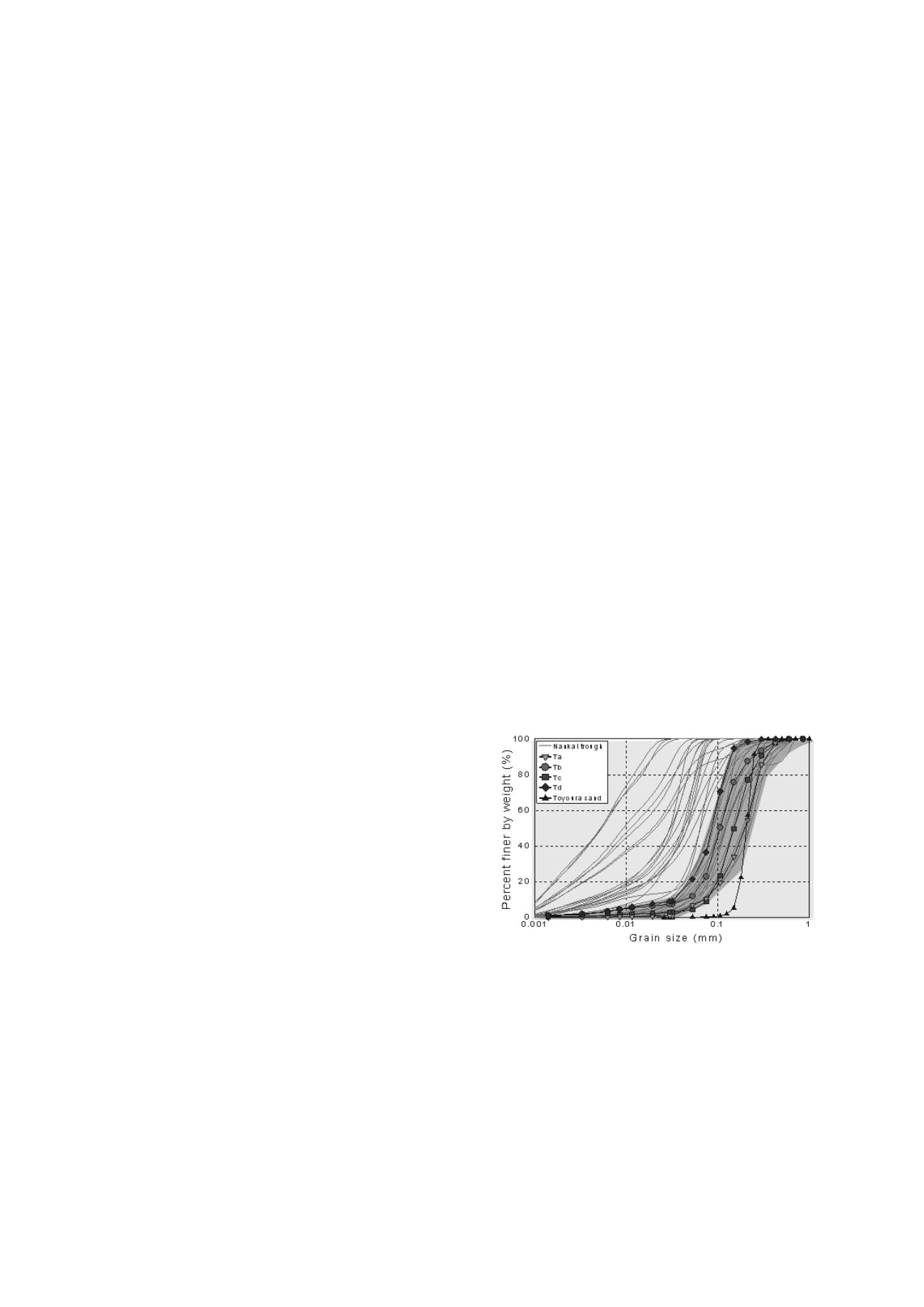
1011
Proceedings of the 18
th
International Conference on Soil Mechanics and Geotechnical Engineering, Paris 2013
SHEAR STRENGTH AND DEFORMATION OF METHANE HYDRATE BEARING
SAND WITH FINES
Résistance au cisaillement et déformation des sables avec des fines contenant
de l’hydrate de
méthane
M. Hyodo, N. Yoshimoto & A. Kato
Yamaguchi University, Ube, Japan
J. Yoneda
The National Institute of Advanced Industrial Science and Technology, Tsukuba, Japan
ABSTRACT: A series of triaxial tests has been carried out to determine the mechanical properties and dissociation characteristics of
sands with fines containing methane hydrate, using an innovative high pressure apparatus which has been developed to reproduce the
in-situ conditions expected during proposed methane extraction methods. It was found that the strength of MH sand increased with
MH saturation due to particle bonding and that the bonding effect was particularly dependent on the grain size of the host sand. A
high pressure and low temperature plane strain testing apparatus was also developed for visualizing the deformation of methane
hydrate bearing sand due to methane hydrate production. Using this testing apparatus, plane strain compression and methane hydrate
dissociation by depressurization tests were performed with the measurement of localized deformation.
RÉSUMÉ: Une série d'essais triaxiaux ont été effectués pour déterminer les propriétés mécaniques et les caractéristiques de
dissociation des sables avec des fines contenant du hydrate de méthane (MH), en utilisant un appareil innovant de haute pression qui
a été développé pour reproduire les conditions in-situ attendues pour des méthodes proposées d'extraction du méthane. Il a été
constaté que la résistance du sable avec MH augmente avec la saturation du MH due au collage des particules et que l'effet de collage
est particulièrement dépendant de la granulométrie du sable. Un appareil d'essai à haute pression et basse température en contraintes
planes a aussi été développé pour la visualisation de la déformation du sable contenant des hydrates de méthane grâce à la production
de méthane hydraté. En utilisant cet appareil, des essais de compression en contraintes planes et de dissociation des hydrates de
méthane par dépressurisation ont été effectués avec la mesure de la déformation locale.
KEYWORDS: metane hydrate, sand, fines, temperature, high stress triaxial test, high stress plane strain test, local deformation
1 INTRODUCTION
Recently there has been much research into Methane
Hydrate (referred to as MH hereafter) in the deep seabed as a
developable material. In Japan, an MH rich layer was found in
the Nankai Trough and production tests will be performed from
2013 (MH21 Research Consortium, 2012). MH in the deep sea
bed can exist at certain water pressure and temperature
conditions. It exists in the pore space of the sand, bonding the
sand particles. The MH rich layer is located around 100m-300m
from the seabed, in deep seas with depths of over 1000m. As
MH exists in uncemented sand sediments, there are many
geotechnical-engineering related problems in order to confirm
the stability of the production well and the grounds in its
vicinity (Yamamoto. K. 2009). Hyodo, et al. (2008) developed
temperature-controlled high-stress triaxial compression testing
apparatus, and used this to perform a series of shear tests on not
only undisturbed MH bearing sand samples from Nankai
Trough, but also artificially produced MH in Toyoura sand to
investigate the variation of shear strength due to cementation of
MH. In this study, specimens of sand with fines were prepared
to simulate the sediments in Nankai Trough and MH was
produced with various degree of MH saturation in the
specimens. A series of triaxial tests was performed and a newly
developed high-stress plane strain shear testing apparatus with
an observation window was used to investigate the global and
local deformation of MH bearing sand.
2 MATERIALS USED IN EXPERIMENTS
Grain size distribution curves for samples from Nankai Trough
and the simulation materials prepared in this study are shown in
Figure 1. The sediments in Nankai Trough`s seabed soil
constitute turbidite and show stratified layers with wide grain
distribution curves, with contents ranging from sand to clay.
The grain size distribution for the MH rich layer in Nankai
Trough is shown in grey; it is mostly sand with fines content. In
order to simulate the grain size distribution and minerals of this
layer, silica sand, kaolin and mica were mixed and four kinds of
simulated sands T
a
, T
b
, T
c
, T
d
were prepared as host sands. The
fines content increases in order of T
b
, T
a
, T
c
, T
d
and the mean
particle size decreases in order of T
a
, T
b
, T
c
, T
d
.
3 SHEAR CHARACTERISTICS OF MH BEARING SANDS
BY TEMPERATURE-CONTROLLED HIGH-STRESS
TRIAXIAL TESTING
Figure 1 Grain size distribution curves (Nankai trough and
artificial samples)
Shear Strength and Deformation of Methane Hydrate Bearing Sand with Fines
Résistance au cisaillement et déformation des sables avec des fines contenant de l’hydrate de
méthane
Hyodo M., Yoshimoto N., Kato A.
Yanaguchi Universit, Ube, Japan
Yoneda J.
The National Institute of Advanced Industrial Science and Technology, Tsukuba, Japan


